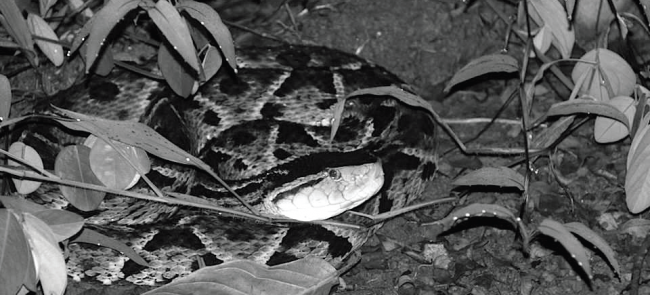

Photo Credit / Dr. Thomas LaDuke
By Briana Magistro
SC Staff Writer
With a venomous bite and exquisite hunting skills, pit vipers slither and slink in all parts of the world. There are over 150 recognized species of pit vipers which reside as far west as Eastern Europe and as far east as Japan. They are also found from Canada to Central and northern South America.
Depending on the species, these snakes can grow as large as 12 feet long. The largest venomous snake — and pit viper — in the Americas is the bushmaster, which lives in all parts of northern South America.
Some species, like the Western Diamond-Back Rattlesnake, enjoy living in the desert and brush climates of the southwestern United States and northern Mexico. It is estimated that this snake is responsible for the majority of snakebites in northern Mexico and the second most common bite in the US.
Other pit vipers, like the cottonmouth, live in a semi-aquatic environment such as living in and around swamps. The cottonmouth is a common serpent of the southeastern United States. This snake gains its common name from its protective behavior. When threatened, the cottonmouth will open its mouth very wide, displaying a white, puffy lining around its jaw. It is also called the water moccasin.
Rainforests can also be home to pit vipers, like the palm viper. These snakes are found in Central and South America. Subspecies of palm vipers can either be active during the day or night. If the snake lives at a higher altitude, it is more likely to be active during the day.
Most pit vipers are active at night, like the Hum-nosed Viper. Its favorite prey, frogs and small mammals, are nocturnal. This snake is one of the smallest pit vipers and is found in India and Sri Lanka.
Some pit vipers hibernate during the winter. The copperhead, a snake common to the eastern US, will find rock cliffs and other safe dens for colder months. A few species will even group in nests to radiate heat.
What sets this group of snakes apart from other venomous snakes is the heat-sensing organ found near their noses. This is called the pit organ. Pit vipers cannot see very well, especially at night, so they rely on these organs.
The pits work like infrared sensors. Infrared radiation given off by animal prey is picked up by these organs and gives the snake a sense of where the prey is located. Having a set of pit organs located on either side of the head allows snakes to zeroin on prey. This gives them an estimated accuracy of more than 99 percent. Researchers have determined that pit vipers can detect prey that has less than 1 degree Celsius temperature difference in comparison to the surrounding environment.
Most pit vipers give birth to live young. The Common Lancehead, found in the Andes Mountains of South America, has been recorded to birth over 80 offspring in one session. Few vipers lay eggs and these are found mostly in Asia. When they do lay eggs, they are aggressively protective.
Baby vipers are usually born with a brightly colored tail and an innate instinct to hunt. Even in infancy, vipers can attract and kill prey. They will wiggle their bright tails, simulating a worm, to persuade small prey to venture closer.
Pit viper venom is hemotoxic, meaning that it affects red blood cells and causes cell destruction and tissue damage. Swelling and intense pain are common symptoms at the bite site.
If left untreated, the toxin can travel throughout the body and cause necrosis of a greater mass of tissue and even muscle. Typically, this results in the loss of a limb or even death from infection. The venom aids in digestion for the snake, as its prey’s muscles and tissues are already being broken down from the inside.
Some vipers, like the Mojave Rattlesnake of Mexico, also possess a neurotoxin in their venom. These toxins kill much faster than hemotoxins alone because they paralyze prey and affect the nervous system.
If you fear a venomous snake may have bitten you, it is highly suggested that you seek medical attention immediately. It is also recommended that you take a picture of the snake, or bring the specimen to the medical center.
Most snakes, especially those found in the Americas, are not aggressive toward humans unless guarding a nest or provoked. As many animals much smaller than a human, vipers would rather flee than fight. If you see a snake in the wild, it is suggested that you walk away from it. Be wary of where it was located, as it may be guarding a nest.
Email Briana at:
bmagistro@live.esu.edu
